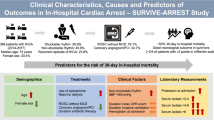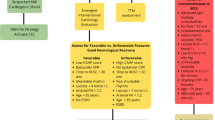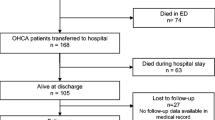Abstract
Fibrinolytic therapy (FT) during out-of-hospital cardiac arrest (OHCA) has been studied in several trials, but they have produced unsatisfactory results even in the most recent Thrombolysis in Cardiac Arrest (TROICA) study. This study aimed to assess the impact of FT provided by an out-of-hospital emergency physician on the immediate prognosis of patients with OHCA. We performed a retrospective study in which the primary endpoint was survival to hospital admission. Among 5,102 patients with OHCA in Paris and the suburban area who received medical care from the Fire Brigade of Paris, 1,261 met the following inclusion criteria: age above 18 years with non-traumatic OHCA. Among 107 patients who received FT, 51 (47.7%) survived to hospital admission whereas 272 out of 1,154 (23.6%) patients who did not receive FT survived to hospital admission. A matching process based on a propensity score used to equalise potential prognosis factors in both groups demonstrated that FT was associated with more frequent survival to hospital admission (OR adjusted: 1.7; CI 95% [1.09–2.68]). This result was observed particularly in patients who were not initially shocked by automatic electrical defibrillator (AED) (ORa = 3.61; CI 95% [1.88–6.96]). This study showed that fibrinolysis was associated with improved survival to hospital admission, after performing a propensity analysis. FT may be beneficial in out-of-hospital arrest patients. However, any conclusions drawn are limited by the retrospective nature of the study.



Similar content being viewed by others
References
Goldstein P (2002) L’arrêt cardiaque en 2002. Une nouvelle course contre les morts évitables. Ann Fr Anesth Réanim 21:547–549
2005 American Heart Association Guidelines for Cardiopulmonary Resuscitation and Emergency Cardiovascular Care. Circulation 112(24 Suppl):IV1-203 (2005)
Lederer W, Lichtenberger C, Pechlaner C et al (2004) Long-term survival and neurological outcome of patients who received recombinant tissue plasminogen activator during out-of-hospital cardiac arrest. Resuscitation 61(2):123–129
Böttiger BW, Bode C, Kern S et al (2001) Efficacy and safety of thrombolytic therapy after initially unsuccessful cardiopulmonary resuscitation: a prospective clinical trial. Lancet 357:1583–1585
Fatovich DM, Dobb GJ, Clugston RA (2004) A pilot randomized trial of thrombolysis in cardiac arrest (the TICA trial). Resuscitation 61:309–313
Böttiger B, Arntz HR, Chamberlain DA et al (2008) Thrombolysis during resuscitation for out-of-hospital cardiac arrest. N Engl J Med 359(25):2651–2662
Jacobs I, Nadkarni V, Bahr J et al (2004) Cardiac arrest and cardiopulmonary resuscitation outcome reports: update and simplification of the Utstein templates for resuscitation registries. A statement for healthcare professionals from a task force of the international liaison committee on resuscitation. Resuscitation 63(3):233–249
D’Agostino RB Jr (1998) Propensity score methods for bias reduction in the comparison of a treatment to a non-randomized control group. Stat Med 17:2265–2281
Ahmed A, Zannad F, Love TE et al (2007) A propensity-matched study of the association of the low serum potassium levels and mortality in chronic heart failure. Eur Heart J 28:1334–1343
Li X, Fu QL, Jing XL et al (2006) A meta-analysis of cardiopulmonary resuscitation with and without the administration of thrombolytic agents. Resuscitation 70:31–36
Abu-laban RB, Christenson JM, Innes GD et al (2002) Tissue plasminogen activator in cardiac arrest with pulseless electrical activity. N Engl J Med 346:1522–1528
Recommandations de la société française de médecine d'urgence pour la prise en charge des arrets cardiaques extra hospitaliers. Ann Fr Anesth Reanim 26:1008–1019 (2007)
Spöhr F, Böttiger BW (2008) Emergency medicine and myocardial ischaemia thrombolysis during cardiopulmonary resuscitation available data and recommendations. Anasthesiol Intensivmed Notfallmed Schmerzther 43:226–230
Spöhr F, Wenzel V, Böttiger BW (2008) Thrombolysis and other drugs during cardiopulmonary resuscitation. Curr Opin Crit Care 14(3):292–298
Mysiak A, Nowicki P, Kobusiak-prokopowicz M (2007) Thrombolysis during cardiopulmonary resuscitation: TROICA—lost war or lost battle? Cardiol J 14(4):424–425
Goran KP (2008) Thrombolysis during cardiopulmonary resuscitation should be addressed in guidelines for pulmonary embolism. Eur Heart J 29(24):3066–3067
Cavallaro F, Sandroni C, Bocci MG, Marano C (2009) Good neurological recovery after cardiopulmonary resuscitation and thrombolysis in two old patients with pulmonary embolism. Acta Anaesthesiol Scand 53:400–402
Arntz HR, Wenzel V, Dissmann R et al (2008) Out-of-hospital thrombolysis during cardiopulmonary resuscitation in patients with high likelihood of ST-elevation myocardial infarction. Resuscitation 76:180–184
Author information
Authors and Affiliations
Corresponding author
Rights and permissions
About this article
Cite this article
Renard, A., Verret, C., Jost, D. et al. Impact of fibrinolysis on immediate prognosis of patients with out-of-hospital cardiac arrest. J Thromb Thrombolysis 32, 405–409 (2011). https://doi.org/10.1007/s11239-011-0619-0
Published:
Issue Date:
DOI: https://doi.org/10.1007/s11239-011-0619-0




